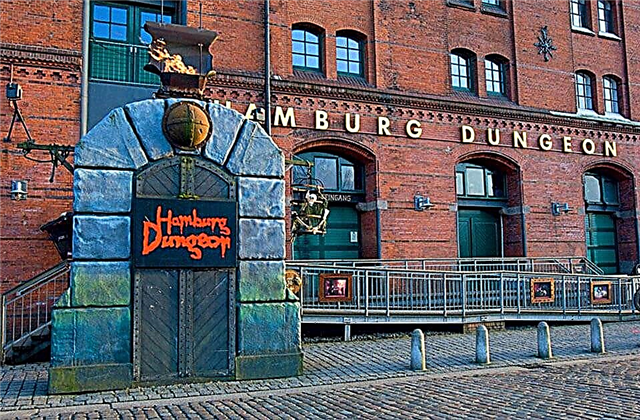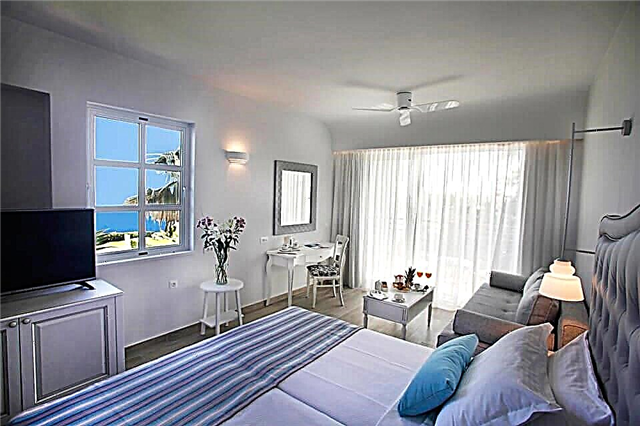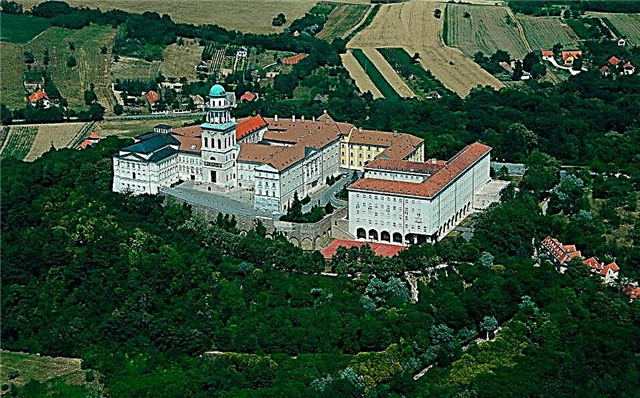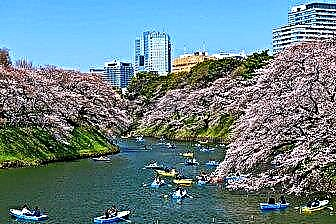Tokyo is one of the busiest metropolitan areas in the world. And here local authorities and residents treat each square meter with typical Japanese zeal. The city's districts are densely built up. Skyscrapers are adjacent to low buildings of past centuries. This shows the continuity of tradition, but allows the streets to be modernized.
Fans of everything unusual should pay attention to the museums of Tokyo. For example, at the Samurai Museum, you can try on armor, and at the Mega Web Exhibition Center, you can ride a retro car. Observation platforms allow you to see the beauty of the Japanese capital from above. One of the best is located in the Tokyo Television Tower.

The best hotels and hotels at affordable prices.
from 500 rubles / day
What to see and where to go in Tokyo?
The most interesting and beautiful places for walking. Photos and a short description.
Ginza, Harajuku, Akihabara and Odaiba Island
The main and most interesting areas of the city. They differ in architecture, they have different functions and "specialization". Akihabara is famous for its retail outlets, it is the center of the anime and IT industry. Ginza has the most expensive hotels, first-class restaurants and great shopping. You can also shop while walking around the Harajuku quarter, but here prices are more democratic, and cosplay fans gather. The artificial island of Odaiba is an attraction in itself.

Tokyo Imperial Palace
It is located on the grounds of the former Edo Castle. The area, including the gardens, is just under 7.5 km². It has been used as a residence since the middle of the 19th century. The architecture has features of both traditional Japanese style and elements characteristic of Europe. The complex includes a number of buildings, including the Imperial Concert Hall and the buildings of the Ministry of the Court. Tourists can only visit the Oriental Garden.

Meiji shrine
Built in 1920 in Yoyogi Park and dedicated to Emperor Mutsuhito. Inside is a collection of things of the ruling dynasty at that time. Guests, if desired, receive omikuji for a nominal fee - a prediction on a piece of paper. Along the perimeter, the temple is surrounded by a fence with figured carvings. The entrance to the territory is through a large wooden gate. Immediately behind them is a garden where you can find 80 varieties of irises.

Senso-ji Temple
Its history dates back to 628. It is considered the oldest Buddhist temple in the Japanese capital. Its foundation is associated with the discovery of a statue of the Bodhisattva Kannon. For several centuries, trade was allowed near the temple. This tradition has survived to this day: right from the gate begins a street with souvenir shops and stalls with sweets. A large fair is held on Senso-ji grounds once a year.

Tokyo Tower
Construction lasted for a year and a half and ended in 1958. The design easily withstands wind gusts up to 90 m / s. In addition, it has been repeatedly tested for its ability to cope with the seismic activity of the region. The height is 333 meters, which is 13 more than the Eiffel Tower. There are observation platforms on two levels - 150 and 250 meters.

Tokyo Skytree
The translation of the name is "Tokyo sky tree". Opened in 2012. With a height of 634 meters, it is the tallest TV tower and the second tallest structure in the world. It is highlighted in either sky blue or magenta. Resistant to earthquakes. It is used not only for its intended purpose: there are observation decks, boutiques, restaurants. A complex with a planetarium, an aquarium and retail space has been built nearby.

Theater "Kabukiza"
Founded in 1889. Location - Ginza. It is the city's main kabuki theater. The building has been reconstructed several times, retaining the features of its original appearance, but changing a lot. It suffered both from time and from cataclysms, such as fires and earthquakes. Accommodates 1964 spectators. For the convenience of visitors, an underground passage has been opened, laid from the theater to the Higashi-Ginza station

Tokyo National Museum
Located in Ueno Park. Its history dates back to 1872. One of the oldest and largest museums in Japan. The area is over 100 thousand square meters. The museum is a complex of 5 buildings. Each has a specific theme. The established exhibition area has been available to visitors since 1938. Here are examples of applied and fine arts, as well as artifacts related to history and ethnography.

Edo-Tokyo Museum
Dedicated to the history of Edo - as Tokyo used to be called. Opened in 1993. The building is 62.2 meters high, which is the same height as the ancient Edo Castle. The exposition is divided into two segments. The first - from 1590 - the year of foundation of the city to 1868, the second - from the moment of renaming to the present day. Among the exhibits there are models of ancient buildings, scrolls, kimonos. Interactive programs have been developed that immerse guests in the past.

Mega Web
The main auto museum in Japan. Thanks to the founders - the Toyota concern, this place has turned into a real amusement park. The exposition includes 6 exhibitions. Cars of the present and the future are located on several floors. In one of the rooms, everyone who knows how to drive a car is allowed to ride on the samples presented here. There is also a children's karting track, the length of the track is 150 meters.

Samurai museum
Located in the Shinjuku area. The spacious halls display the armor and weapons of the samurai. Most of the items are originals. Standard armor was only used in combat. Your guide will tell you how to put them on correctly. For an additional fee, some samples can be tried on. Taking photographs in the museum is permitted, with the exception of a few pictures that are particularly sensitive to flash.

Nezu Museum
It is located in a picturesque garden among streams, teahouses and paths. Based on a private collection. The building was reconstructed in 2006, from that moment the modern history of the museum is being conducted. The collection is a national treasure of Japan. Calligraphic scrolls, gold-painted boxes, bronze dishes, folding screens - these and other exhibits introduce Japanese traditions.

National Arts Center
It opened its doors to connoisseurs of beauty in 2007. The area of the exhibition halls is 14 thousand square meters. One of the most visited art museums in the world. Its peculiarity is the absence of a permanent exhibition. Within its walls, the arts center hosts temporary exhibitions. The museum cooperates with other cities, including foreign ones, and also acts as a platform for demonstrations of private collections.

National Museum of Western Art
Belongs to Taito County. Based on the collection of Matsukata Kojiro. For his collection of more than 350 objects of art, an exhibition building was built by 1959. It was subsequently completed to increase the number of halls. Now about 2 thousand exhibits have been collected under one roof. Exposition - paintings, sculptures, graphics and drawings of Europe and North America from the Middle Ages to the XX century.

National Museum of Nature and Science
Refers to the territory of Ueno Park. Has been working since 1871. The names were changed several times, although the profile remained the same. At the turn of the 90s and 2000s, the museum went through modernization. It is divided into two galleries: the Global one tells about the planet as a whole, and the Japanese one - about the peculiarities of the country. The purpose of the museum is to convey information about the stages of evolution to visitors of all ages in an accessible way. Since 2006 "Theater-360" has been opened.

Mori Art Museum
Located on the top two floors of the Mori Tower - at an altitude of 238 meters. Because of this, it is considered the tallest museum in Tokyo. An observation deck area is arranged along the perimeter. The first exhibition opened in 2003. The exhibition includes works by contemporary Japanese and foreign artists. Pictures from private collections are also displayed here.For example, the canvases of Monet, Kandinsky and Matisse.

Monument to Hachiko
Installed in 1934. Dedicated to a dog named Hachiko, who, thanks to literature and cinema, became famous even outside Japan. For many years he came to Shibuya Station to meet his master. He died, but Hachiko did not stop coming to the train, as on schedule. The symbol of loyalty was melted down for the needs of the army during the Second World War. The monument was restored in 1948.

Shibuya Crossing
It is considered the busiest intersection on the planet. During peak hours, it is crossed by 2.5 thousand people in just a minute. This is how long the green traffic light is on for pedestrians. More than 2 million people can pass here a day. Crossroads with such a complex arrangement are found in other countries as well. All of them are called "Barnes Dance" in honor of the transport engineer who introduced them to fashion.

Akasaka Palace
Built at the turn of the 19th and 20th centuries. It is the only neo-baroque building in Japan. Reminiscent of Buckingham Palace. It is the guest house of the government - high-ranking representatives of other countries live here. Since 2009 it has been awarded the status of a National Treasure of Japan. The complex covers an area of 117 thousand square meters. The palace is surrounded by a road without intersections with a length of about three and a quarter kilometers.

Tokyo Metropolitan Government Building
Also called Tokyo Municipality. This complex of buildings has been the seat of the metropolitan government since 1991. The structure is one of the tallest in Tokyo - almost 243 meters. It has 45 floors and 3 more underground levels. 3 buildings are connected by bridges, and between them a fan-shaped courtyard with a park laid out next to it was formed. The structures are seismically resistant and must withstand a magnitude 8 earthquake.

Ryogoku Kokugikan
The indoor sports arena opened its doors to visitors in 1985. Located in Yokoami District. Most of the spectators are attracted by the sumo competition. Major tournaments take place in January, May and September. In addition, Ryogoku Kokugikan is suitable for boxing matches and performing arts. There is a shop on the underground level that sells fried chicken. Part of the roof opens when needed.

Station "Tokyo"
The station building was built in 1914. Architect - Tatsuno Kingo. The red brick and some of the design features are reminiscent of the Dutch style. Inside there is a real labyrinth of platforms, stairs, lifts and passages. About 4 thousand trains pass through the station every day. Most of them are high-speed ones. From here, for the convenience of passengers, there are exits to the nearest metro stations.

Rainbow bridge
Moved across northern Tokyo Bay in 1993. The total length of the suspended structure is 798 meters with a width of 49 meters. The name is derived from the backlight. Moreover, the lamps run on solar panels, which is economical and good for the environment. For pedestrians, two crossings have been made on the lower tier. The walk will not only help you get to the island of Odaiba and back, but also see the sights of the area.

Tsukiji Market
It is also called "fish" among the locals, although other products are also sold here. About 2 thousand tons of seafood and fish are sold on the market per day. Consists of two parts. On the domestic market, there are wholesales, trading and processing of products. On the outside, you can buy both wholesale and retail. There are cafes and restaurants here. Most of the points open very early and close in the morning.

Shinjuku Gyoen
The park belongs to the territory of two districts at once: Shibuya and Shinjuku. The first park was closed and appeared in 1906. It was destroyed during World War II. It was reopened in 1949. All citizens and guests of Tokyo got access. The early spring cherry blossoms are especially attractive for locals and tourists. The total number of trees is about one and a half thousand. They represent 75 species.

Ueno Park
Broken in 1873. It houses several museums, including the Tokyo National Museum. Also, tourists are attracted by the temple of the goddess Kannon, where barren women pray. When they become pregnant, they donate a doll. Traditionally, toys are burned once a year. The local zoo is home to over 2,500 animals. Especially famous are the two pandas, who replaced the deceased universal favorite Lin-Ling.

Hamarikyu Gardens
Located in the Chuo area. Broken in 1946. The area is over 25 hectares. The park is surrounded by a moat filled with the waters of Tokyo Bay. Traditional events - New Year's falconry, tea ceremony in a teahouse in the center of the gardens, demonstration performances of aikido fighters. You can get to the park through one of two bridges or by water tram. The visit is paid for everyone except local schoolchildren.

Yoyogi Park
Located near Harajuku Station. Famous for conducting the first plane flight in the country, which took place in 1910. Since then, the park has hosted military parades. The rest of the time it is used for rest. There are sports fields, a bike path, bike rental, martial arts practice areas. In parts of Yoyogi's territory, dogs can walk off a leash, which is unique in Japan.

Chidorigafuchi
The place is considered one of the most romantic in Tokyo. More than 300 trees have been planted along a deep ditch filled with water. They hang over the banks and look like floating clouds during the cherry blossom season. A popular pastime is boat trips. The pier and the rental point are very conveniently equipped. However, you must be ready to stand in line, as it is traditionally crowded here.

Disneyland
Opened since 1983. Occupies an area of 465 thousand square meters. Became the first Disney amusement park to be founded outside the United States. The rides are located in 7 thematic zones: the Country of the Wild West, the Land of Animals, the Land of Fantasy, the Land of Adventures, the Land of the Future, as well as in the City of Toons and the Universal Bazaar. A single ticket for visiting, it is bought at the entrance, and admission to the attractions is on a first come, first served basis.












